Homemade salted caramel macarons are one of the most delicious and elegant treats you can make! They consist of crispy, French macaron shell, salted caramel swiss meringue buttercream, and a pool of hidden salted caramel in the centre. Each macaron is toped with a drizzle of more caramel, chocolate, and sea salt flakes for the ultimate sweet and salty flavour experience!
With crunchy exterior, and soft, chewy inside, filled with creamy buttercream and caramel, these caramel macarons will be your love from first bite!
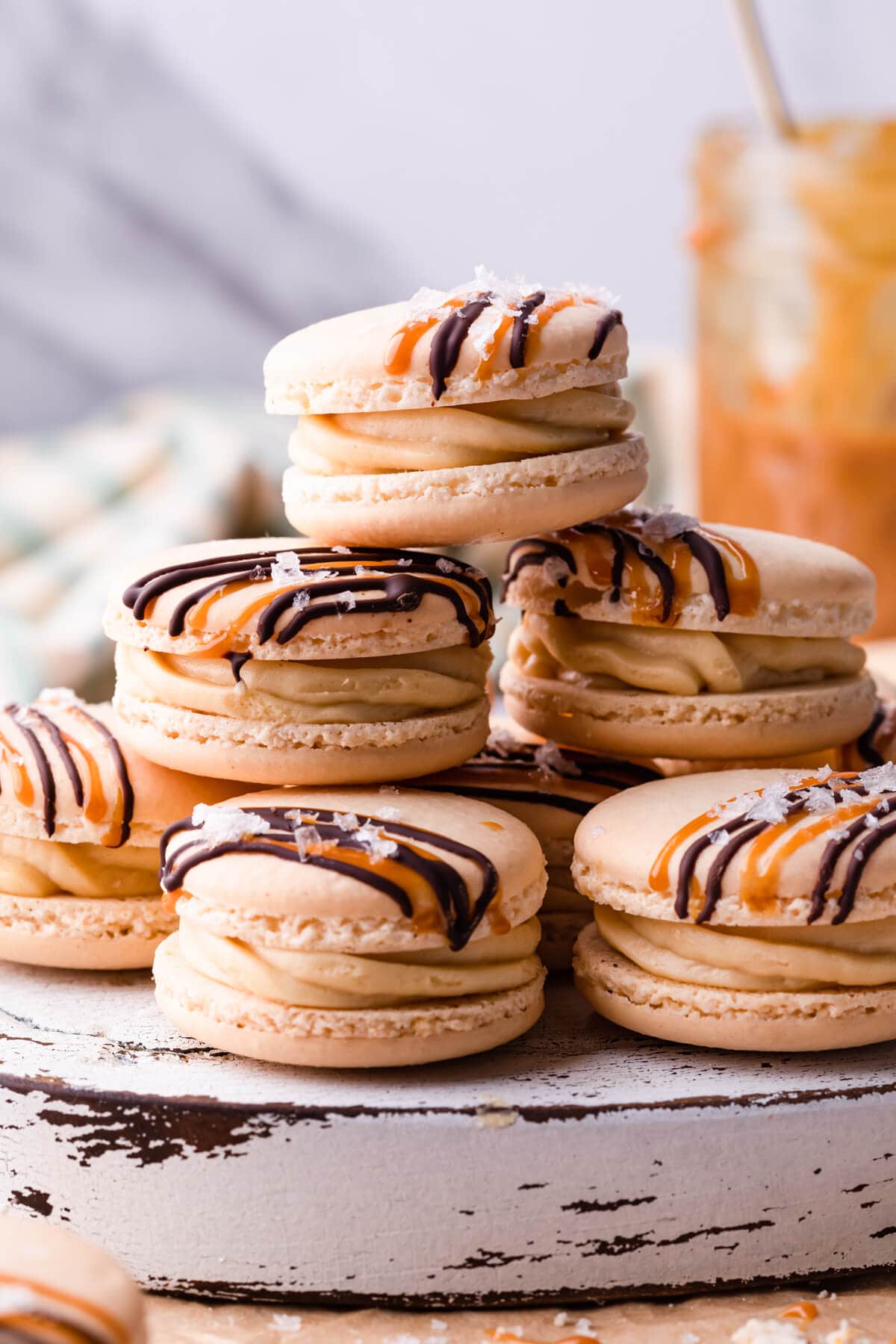
Macarons are one of these treats that are fantastic to enjoy during any occasion or gathering, all year round. They are pretty, elegant, and most of all - completely irresistible! These salted caramel macarons will also make a fantastic and thoughtful gift for the loved ones during the festive season.
If you are looking for some more edible gifting ideas for friends and family, you may want to check my Danish Butter Cookies, Lemon and Pistachio Biscotti, or my Dulce De Leche Stufed Cookies. All of these make great and delicious gifts for Christmas and beyond.
Jump to:
Ingredients
To make the macaron shells, you will need the following ingredients:

- Egg whites - Room temperature egg whites to make the meringue with.
- Sugar - Caster or granulated sugar, to help stabilise the meringue and add the sweetness.
- Ground almonds or almond flour - To give macarons that soft and chewy texture.
- Icing sugar - Powdered sugar helps with soaking up the moisture from the macaron batter and is responsible for the characteristic macaron 'feet'.
I'm using the swiss meringue buttercream flavoured with salted caramel for the filling. Here's what you will need to make it:
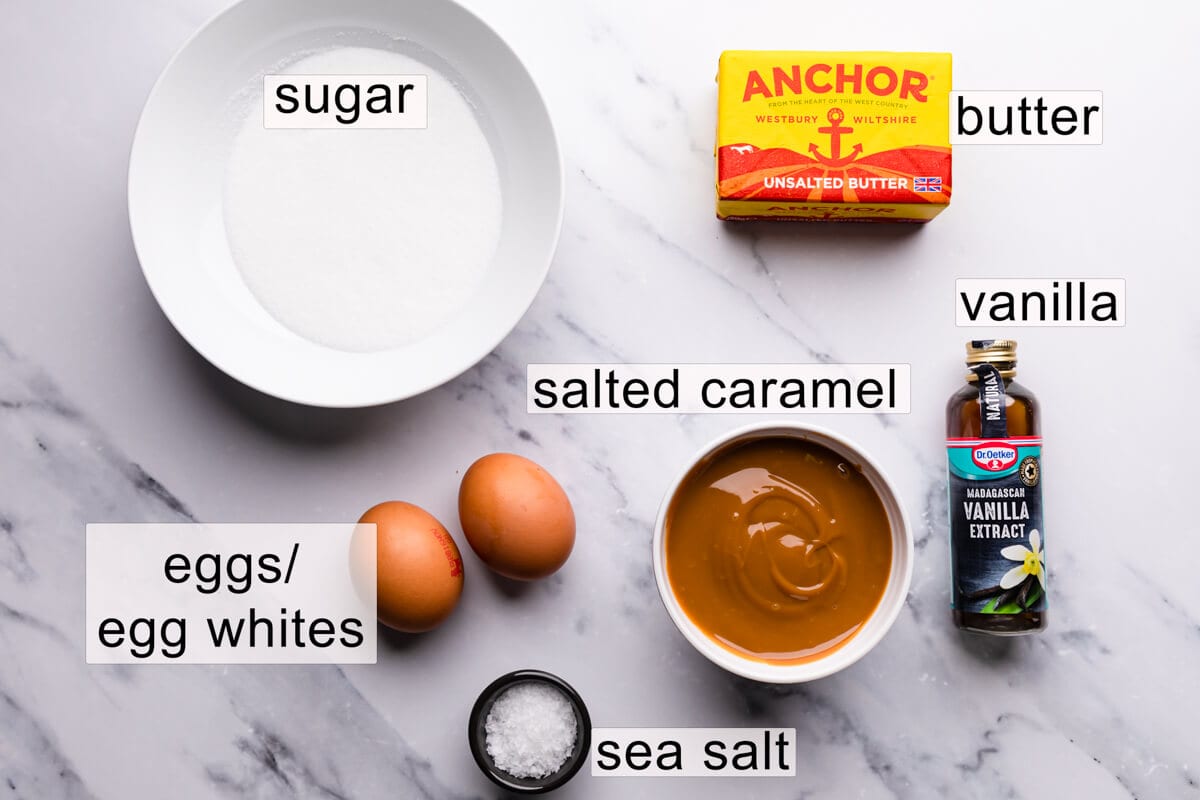
- Egg whites.
- Sugar.
- Butter.
- Salted caramel.
- Vanilla extract.
- Salt.
Scroll to the bottom of this post for the recipe card and the full list of the ingredients.
Instructions
I strongly recommend watching the video before starting this recipe.
I find it easier to start this macaron recipe by making the filling first. But it is totally up to you in which order you make it.
Macarons have a bit of a reputation for being fussy, demanding and difficult to make, but I think it's all down to trying and experimenting with the recipe. But making macarons is actually quite easy, and once you learn how to make them, it will be a treat that you bake on repeat!

Sift the ground almonds or almond flour and icing sugar. Dispose of any particles remaining in the sieve.

Make the meringue. Ensure it forms stiff peaks that shoot upwards and not to the sides. Add the almond flour/ ground almonds and icing sugar into the meringue.
Hint: Use fine kitchen sieve to catch any larger grains/ almond particles. Sift the almonds/ almond flour twice, to achieve the superfine texture. This way you will avoid your macarons looking gritty and bumpy.
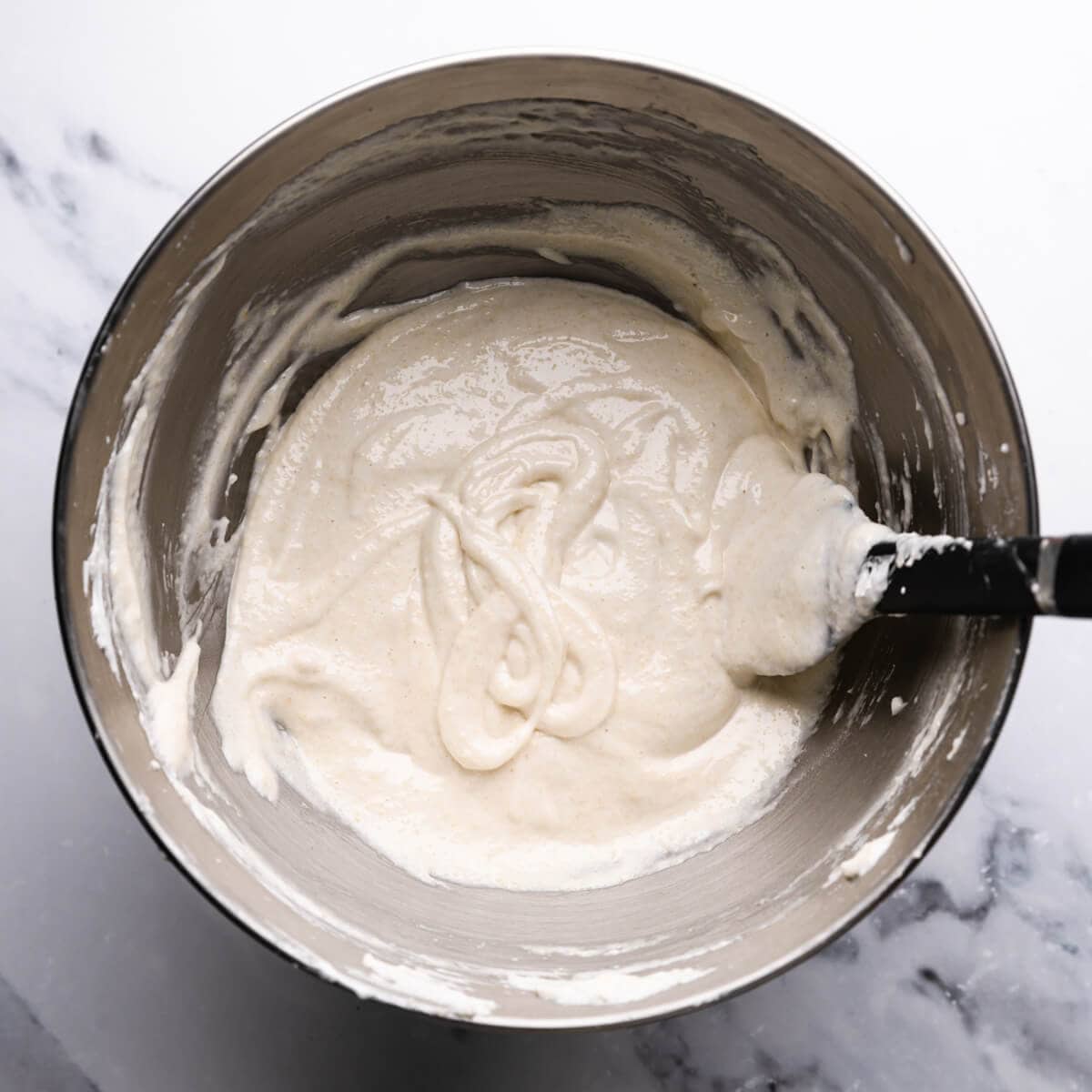
Fold the batter until it is shiny and glossy and it falls in thick ribbon off the spatula. You know it's ready when you can 'draw' a figure of 8 with the batter, without the batter breaking.

Pipe the macarons into prepared baking sheets. Tap the trays gently against the kitchen surface and pop any air bubbles on the surface of the shells. Allow the macarons to rest until they are dry and have developed 'skin', before baking in the oven.
Hint: It is always better to under-mix the batter slightly, rather than over-mix it. It should flow into the bowl in small ribbon-like chunks. The ribbon should also fade back into the batter within about 20 seconds. If it doesn't, fold the batter few more times. 3-4 folds at a time is what you want to aim for.
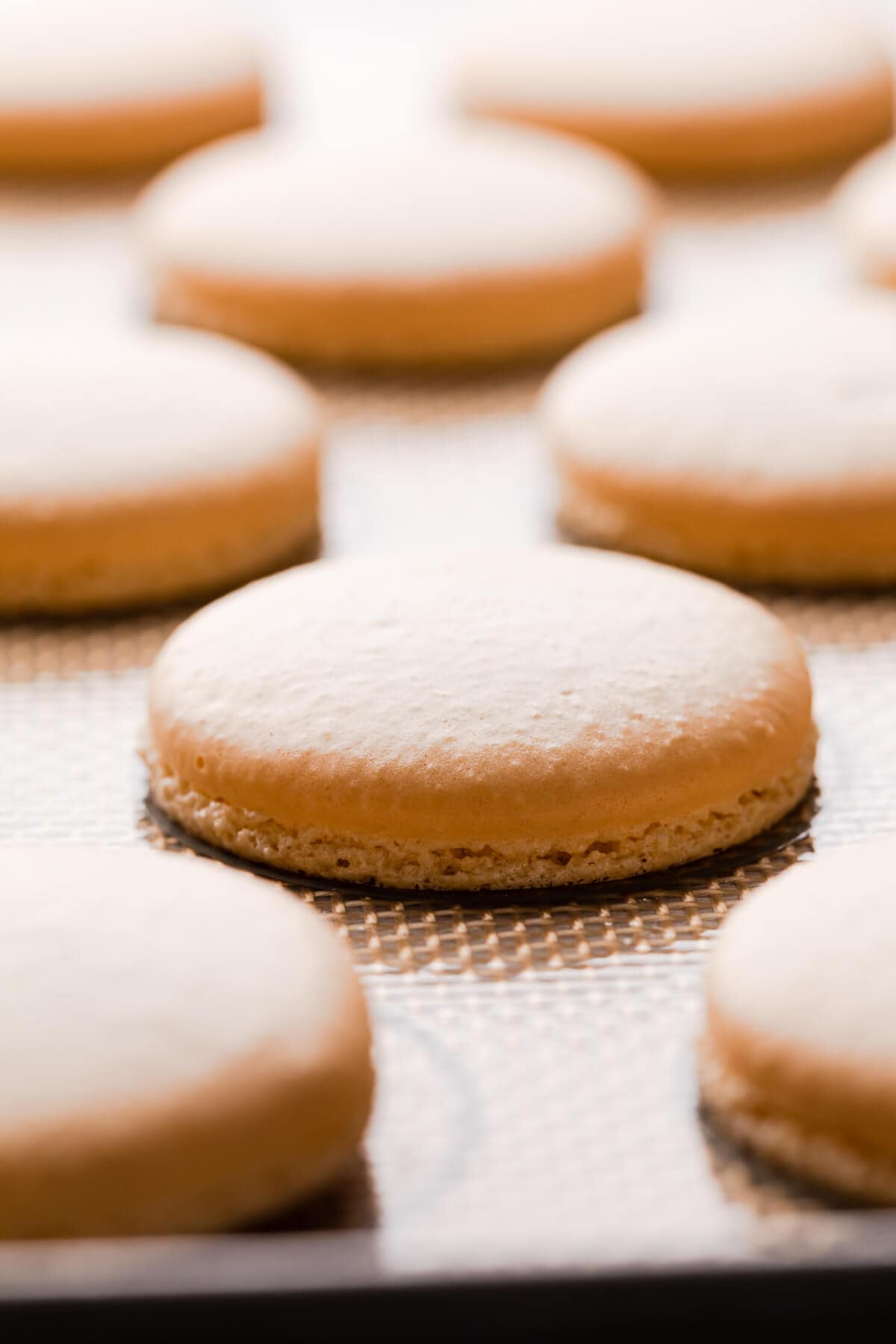
How to assemble macarons
When you are ready to assemble your salted caramel macarons, start to match similar sized shells with each other. Be gentle when peeling the macaron shells from the baking paper/ baking mats. They are very delicate and if you just try to lift them up, they will break apart.

Line one row of the shells which will be the tops, and another row for the bottoms, flat side up.
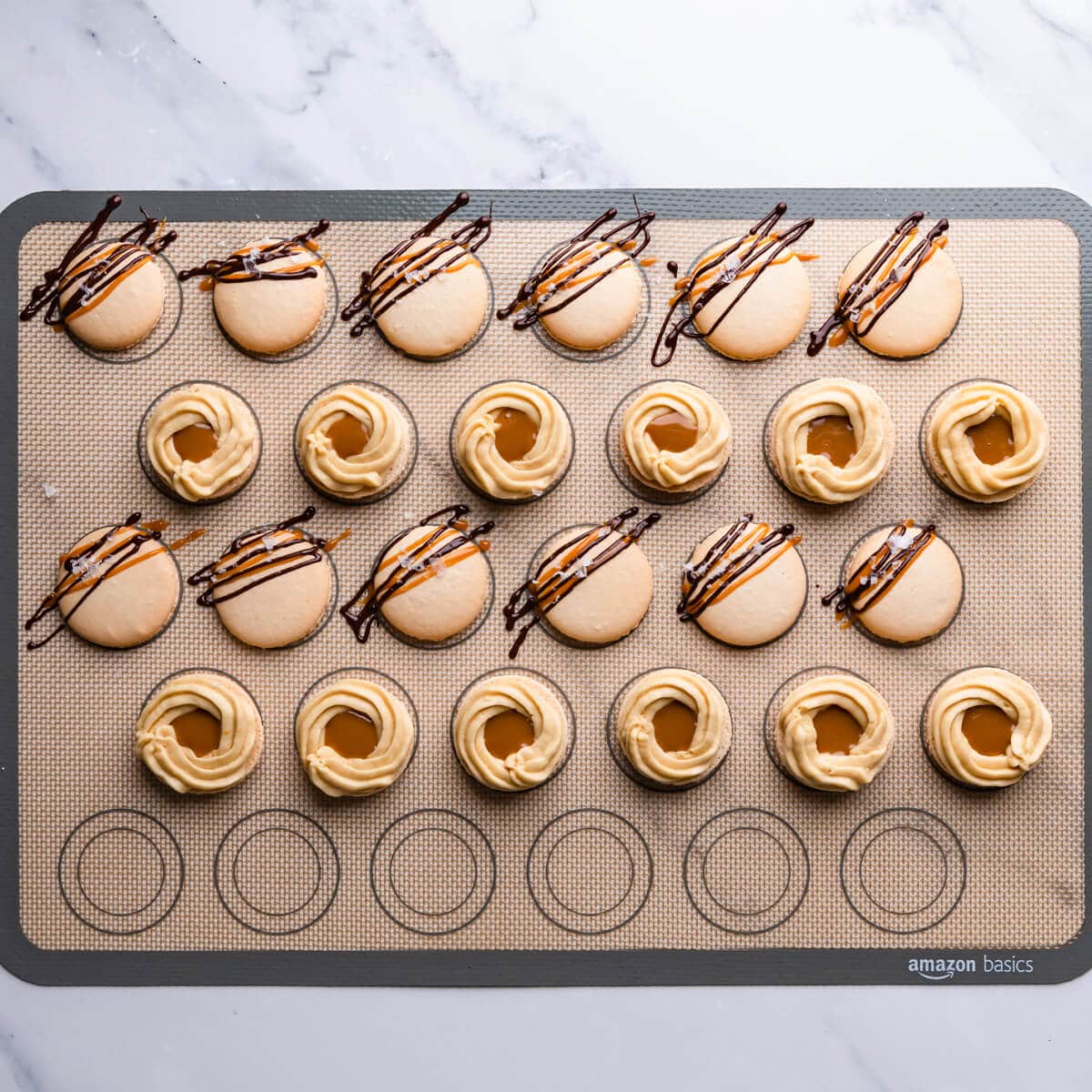
Drizzle the caramel and melted chocolate over the tops, then sprinkle the sea salt flakes on each macaron top.
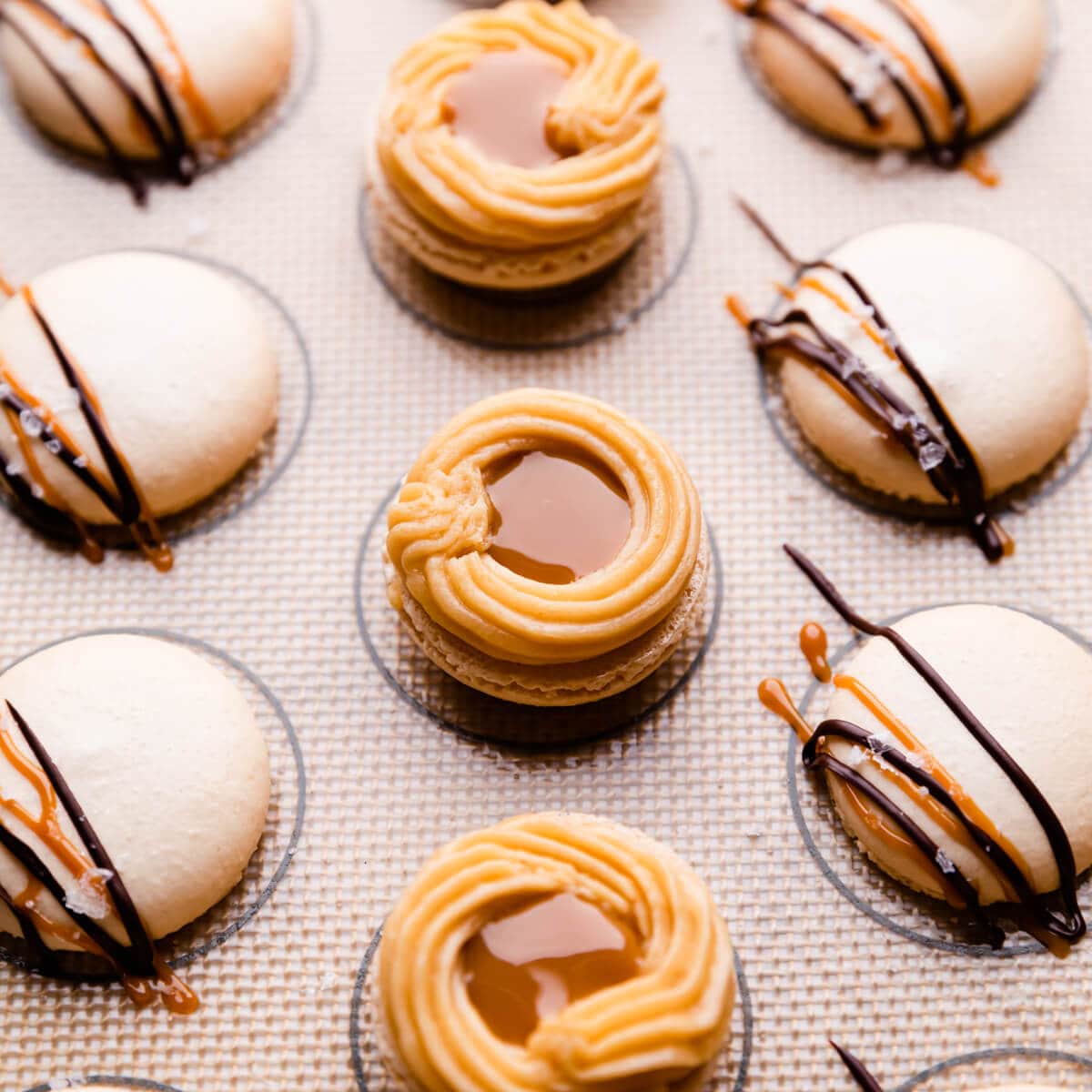
Pipe a boarder of caramel buttercream on flat side of each macaron bottom. Fill the centre with salted caramel.

Top each bottom of your salted caramel macaron with the matching top shell and press gently to sandwich them together.
Hint: Allow the macarons to sit in the fridge overnight. This will develop their flavour to full potential. Remove them from the fridge and bring to room temperature before serving.
Substitutions
Just like with any macaron recipe, it's important to use the precise measurements and to follow the recipe steps exactly as stated in the recipe card. Changing the ingredients or their quantities in even the slightest way, will result in change of the finished bake.
However, there are few replacements and substitutions you may want to try in this caramel macaron recipe:
- Sugar - Superfine caster sugar will work best, but you can also use the granulated sugar instead.
- Ground almonds or almond flour - The ground almonds in the UK supermarkets are blanched, but not as fine in texture as almond flour. That is why it's important to sift the ground almonds at least once, but ideally twice. That way you will get rid of any larger particles and will achieve that super-fine texture and smooth macaron shells.
- Egg whites - Just like in my Pavlova recipe, I prefer to use fresh egg whites for macarons. Some recipes call for aged egg whites, but I find the fresh ones work just as good. You can use the egg whites from the carton instead if you'd like, but from my personal experience I found that they do not produce as stable meringue as the traditional egg whites.
- Swiss meringue salted caramel buttercream - You can use any type of buttercream or ganache instead. To make the simpler version of salted caramel filling, mix 100 g of unsalted butter (room temperature) with 150 g of icing/ powdered sugar and 60 g of salted caramel sauce. Whip it with an electric mixer until soft and creamy.
- Salted caramel - I use ready made, shop-bought salted caramel in this recipe. I also tested it with Carnation caramel filling from the tin, and it works really well. If you prefer to use homemade salted caramel, check out this easy salted caramel recipe from The Loopy Whisk blog.

Variations
- Food colouring - Macarons often come in different colours, thanks to the use of the food colouring. It's best to use gel food colouring, as it will not affect the consistency of the batter. You only need a tiny amount of the colouring, and use the toothpick to add it to the batter.
- Eggless macarons - Check out this eggless macaron recipe from Bake with Shivesh blog for an eggless alternative.
- Different filling - If salted caramel macaron filling is not exactly to your liking, why not try different flavour? Chocolate ganache is a great option ( the ganache from my Chocolate Thumbprint Cookies recipe will work great here). Raspberry or vanilla buttercream are also worth exploring, and so is the lemon curd!
- Add-ons - Try different add-ons like nuts, sprinkles, spreads and jams for the filling and decorations of your macarons.
Equipment
There are few pieces of kitchen equipment which are necessary when baking macarons only. Here's what you will need:
- Kitchen scales - I strongly recommend using digital kitchen scales in this recipe for precise measurements of the ingredients.
- Baking trays/ baking sheets - This recipe makes about 30- 40 macarons, so ideally you want a couple of large baking sheets.
- Baking paper or silicone baking mats - If you are using parchment paper to line the baking sheets with, you may want to draw a round templates underneath it, to help keep all of the macarons identical size/ shape. I like using the silicone baking mats which already have the macaron template on them.
- Piping bag - To pipe the macarons.
- Plain piping nozzle - Large, round piping nozzle to pipe the macarons.
Additionally, for the swiss meringue buttercream and decoration you may want to use the following items:
- Freestanding mixer with paddle and whisk attachment - If you choose the Swiss meringue buttercream for the filling, you want to use a stand mixer. You can make SMB with hand-held mixer, but it will be much more time consuming.
- Kitchen thermometer - Optional item, but helpful when mixing the egg whites and sugar for the meringue buttercream.
- Piping bags - I like to keep each component of the recipe in a separate piping bag, for the ease of it (one for the buttercream, one for salted caramel, and another one for the melted chocolate). But you can also spread the filling with the palette knife or with a spoon. You can also use the spoon for drizzling the caramel and chocolate.
- Small decorative nozzle - Optional, to pipe the ring of buttercream onto the macarons. Use your favourite type or shape.
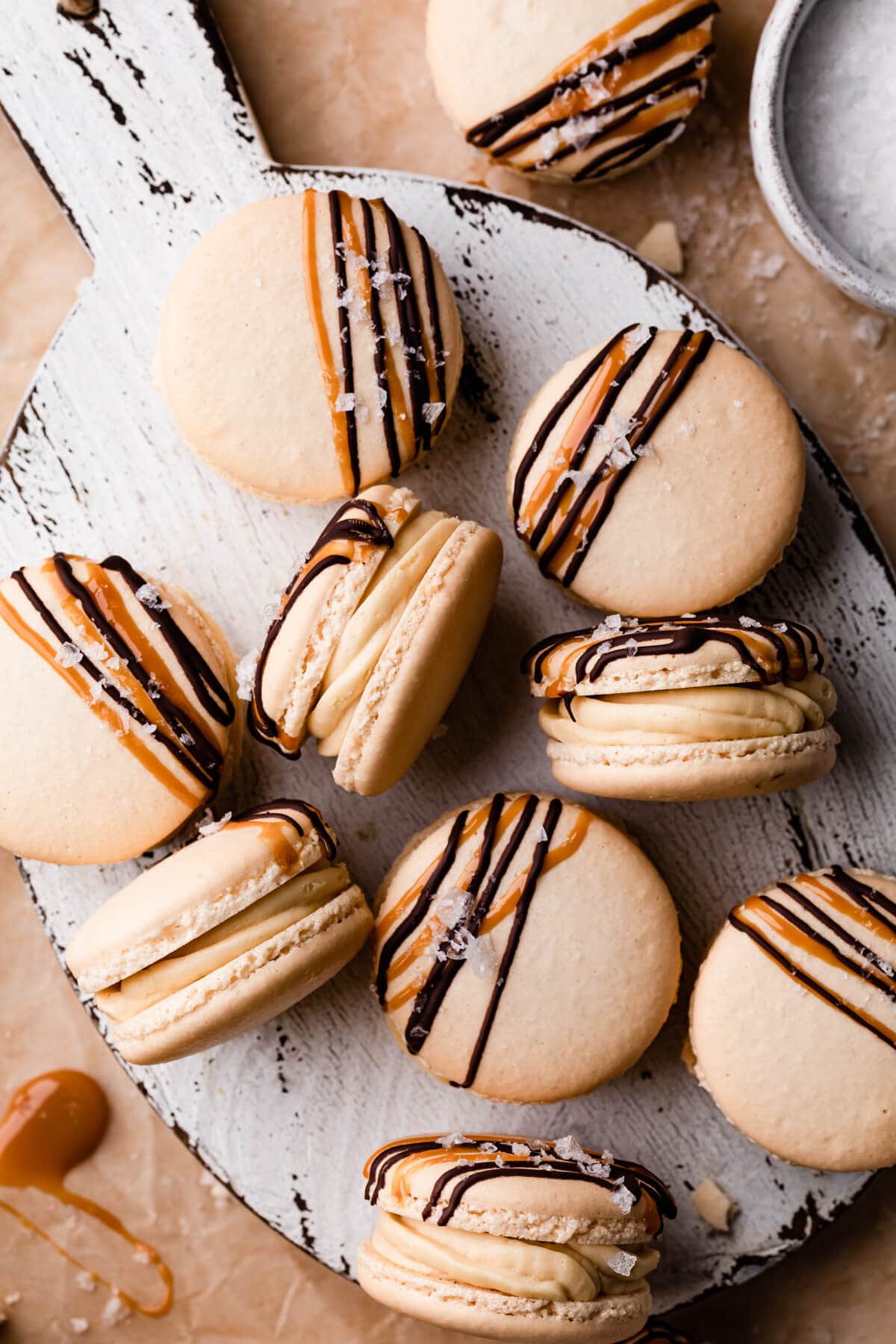
Storage
Store your salted caramel macarons in the airtight container in the fridge for up to 7 days. Serve them at room temperature.
You can also freeze them for up to 2 months. To freeze, use a large airtight container lined with sheets of baking parchment to prevent the macarons sticking together.
Each component of this salted caramel macarons recipe can be easily made in advance. Make the macaron shells up to a day or two ahead and store in an airtight container. Salted caramel buttercream will keep well in the fridge for up to 3 days (you may have to re-whip it again before using).
Any leftovers of the salted caramel can be stored in the fridge or freezer. Salted caramel buttercream is suitable for freezing for up to 3 months. If freezing, transfer it to an airtight container. Thaw it at room temperature, then transfer it to a bowl of an electric mixer and whip it for 2-3 minutes until it is creamy again.

Top tip
There are three crucial stages, for a successful macarons: the meringue, the folding of the batter and drying of the shells. Once you grasp all three, and take extra care during these stages, I promise you will be a macaron pro in no time!
- Meringue - The meringue is the foundation of this cookie. Make sure the bowl is clean and grease-free, and whip the meringue until stiff peaks. They should not be leaning to the side of your whisk when lifted. Instead, they should be shooting upwards.
- Folding of the batter - Your folding will determine the shape and final appearance of your macaron shells. It is probably the hardest part to master, especially when making the macarons for the first time, because it is very easy to over or under-mix the batter. Watch the video of this recipe to fully visualise the folding technique and the consistency of the batter.
- Drying of the shells (aka maturing the macarons) - This stage ensures that your macarons will develop the beautiful feet at the bottom of your cookie. The time it will take for the shells to dry varies on the air temperature, humidity and the climate. It may take 30 minutes, but equally, it may take 2-3 hours before they are dry to the touch. Be patient and wait, as it will be totally worth it!

FAQ
This is one of the most common trouble with macarons. There could be MANY different reasons, but the most common ones are: the oven was too hot, the meringue was over-mixed and trapped too many air bubbles, or your macaron batter was under-mixed. Use an oven thermometer, and always test a small batch of macarons first, to see what temperature works best with your oven (as they do vary greatly). Stop mixing the meringue as soon as it reaches the stiff peaks stage, and fold the macaron batter until it reaches the right consistency.
This could be because your batter was too wet. If you don't allow the macarons to mature and dry out properly before baking, it will more likely result in underdeveloped feet.
If the egg whites are not whipped correctly, or lost their shape when they were folded with the rest of the batter, your macarons will not rise. Also, if the oven temperature is not hot enough, macarons won't rise, as air bubbles in the meringue need heat to expand and lift the shells.

To pin this recipe and save it for later, use the button on the recipe card or on the photos above.
If you try this recipe, or any other recipe on Anna Banana, please take a moment to rate the recipe and/ or leave me a comment. I love hearing from you, but it also helps other readers who are thinking of making the recipe.
📖 Recipe
Salted Caramel Macarons
Equipment
- Digital kitchen scales
- baking trays
- Baking paper or baking silicone mats
- Piping bags optional
- Plain round piping nozzle optional
- Freestanding mixer with paddle and whisk attachment optional
Ingredients
For the macaron shells:
- 110 g egg whites (from about 3 large eggs) room temperature
- 110 g caster or granulated sugar
- 115 g almond flour or ground almonds *see notes
- 115 g icing/ powdered sugar
For the salted caramel Swiss buttercream:
- 2 large eggs, whites only
- 100 g caster or granulated sugar
- 140 g unsalted butter, softened, but still cool and cut into smaller cubes *see notes
- 60 g salted caramel (homemade or shop-bought)
- 1 teaspoon vanilla extract
- ½ teaspoon salt
For decorating:
- 50 g dark or milk chocolate, melted
- 50 g salted caramel
- 1 tablespoon sea salt flakes
Instructions
To make macaron shells:
- Line two baking trays with baking paper or silicone baking mats (mine already have the macron templates on them).
- Sift the almond flour/ ground almonds and icing sugar together into a bowl. Discard any particles that stay in the sieve. If you are using ground almonds, you may want to sift the mixture twice, to get rid of any bigger almond pieces. The finer the texture of this mixture, the finer and less bumpy finish the macarons will have. Set the mixture aside.115 g almond flour or ground almonds, 115 g icing/ powdered sugar
- In a bowl of a standing mixer fitted with the whisk attachment (or using a hand-held mixer with traditional beaters), beat egg whites until soft peaks. Start adding the sugar, gradually, about 1-2 tablespoon at a time and continue to beat until stiff peaks form. The peaks should be pointing straight up when you lift the whisk, and not bending to the side (Watch the video for visuals).110 g egg whites (from about 3 large eggs), 110 g caster or granulated sugar
- Add the icing sugar and ground almonds mixture into the stiff meringue, in two additions, and start folding it, scraping around the bowl and down the centre (watch video for visuals). Once all the mixture is folded in, start pressing the batter around the bowl and then fold it into centre (watch video for visual guidance).
- You should stop folding the batter when it looks glossy and has thick and flowing consistency. You know it is ready, when you can draw a figure 8 with the batter that is dripping off the spatula. If you can draw few 8 figures without the batter breaking up, it is ready. If not, keep folding it, and checking often as you do not want to over-mix it. 3-4 folds at a time is what you should be aiming for.
- Another way to test the batter: It should fall in a thick ribbon from the spatula. The ribbon should fade back into the batter within about 20 seconds.
- Transfer the batter into a piping bag fitted with plain, large, round nozzle. Hold the bag vertically to the tray, with the nozzle about 1 cm above it. Apply a gentle pressure and carefully pipe rounds (about 2.5cm in diameter) for about 3 seconds, then quickly pull the piping bag up, twisting slightly.
- Once you have piped all of the batter, tap the baking trays against the kitchen counter few times, to release any air bubbles formed in the batter. Use a toothpick to pop any air bubbles that you can see on the surface of the macaron shells.
- Let the trays with piped macarons sit for 1-2 hours, or until they have developed 'the skin'. When you gently touch the macaron, it should feel dry.
- Preheat the oven to 150°C. Bake one tray at a time, for about 10-15 minutes, rotating the tray half way through. The baked macarons should have formed 'feet' and will be deeper in colour. If you give your tray a gentle wiggle, macarons shouldn't be moving, that is when they're ready. If they jiggle, you need to bake them for a bit longer.
- Remove the tray from the oven and let them cool completely, before gently peeling them off from baking paper or baking mat.
To make salted caramel Swiss buttercream:
- Whisk the sugar into the egg whites, then set the bowl over a saucepan with gently simmering water over a medium heat. Make sure the bottom of the bowl doesn't touch the water. Whisk the mixture constantly (you can use a hand-held mixer, but you can also whisk by hand) until all the sugar has dissolved, about 5 minutes (it will become frothy and foamy). You can test if it's ready by lightly and quickly dipping your finger (be careful as it will be very hot!), and rubbing the mixture. It should feel smooth, without any sugar grains. You can also use a kitchen thermometer instead. The mixture is ready when it reaches temperature of 71°C.2 large eggs, whites only, 100 g caster or granulated sugar
- Transfer the mixture into a bowl of a standing mixer with paddle attachment. Start mixing on a medium speed, and beat until glossy and stiff peaks form, and the meringue is no longer warm to the touch. This may take a bit of time, sometimes even up to 20 minutes, depending on the humidity.
- Once the meringue has reached the stiff peaks stage, gradually start adding the butter, only a small piece at a time, mixing and beating well after each addition. After you have used all the butter, your buttercream should be thick and firmed up. If it's not, place the bowl with the buttercream in the fridge for 10-15 minutes, then whip it up again.140 g unsalted butter, softened, but still cool and cut into smaller cubes
- Add the salted caramel, vanilla extract and salt and whisk well to combine. Transfer the buttercream into a piping bag with a decorative nozzle of choice.60 g salted caramel (homemade or shop-bought), 1 teaspoon vanilla extract, ½ teaspoon salt
To assemble the macarons:
- Match the similar size macaron shells with each other. Transfer the melted chocolate and salted caramel into separate piping bags. Snip the ends of the piping bags. Drizzle some chocolate over the top shells, then do the same with salted caramel. Sprinkle the flaky sea salt on top of each top shell.50 g dark or milk chocolate, melted, 50 g salted caramel, 1 tablespoon sea salt flakes
- Pipe a ring of the buttercream around the edges of each bottom shell. Pipe a small amount of salted caramel in the middle of each buttercream ring. Place the top shells over the filling and press very gently.
- You can eat them straight away, or place macarons in an airtight container and allow them to sit in the fridge overnight to develop deeper flavour. Enjoy!
Please note that all my recipes are developed and tested in metric grams. I recommend that you use digital scales for a more accurate results. I have provided a conversion to US customary in the recipe but please note that I haven’t tested using this method.
Video
Notes
- Oven temperature: Lots of macaron recipes suggest baking them at 163°C, but I found that my macaron shells crack at this temperature, as it's too hot (for my oven). 150°C is the oven temperature that works for me, in my fan assisted oven, but you may have to experiment with your oven to find your 'sweet spot'. Always test a small batch first, and see which ones turn out best.
- Bake one tray at a time, and rotate it half way through the baking time to ensure your macarons bake and brown evenly.
- Depending on the size of your rounds, the baking times may have to be adjusted. Reduce the baking times for smaller macarons by a couple of minutes, or add few more minutes for bigger size shells.
- To test for doneness, lightly touch the macaron shell with your finger or with a spoon. If the macaron feels wobbly or jiggly, it's not done and will need few more minutes of baking (keep checking every 2 minutes or so). You want to bake them until they no longer move around when touched.
- Let the shells cool completely, before trying to peel the macarons off the baking parchment or the baking mat. If you try to remove them too soon, it may rip them apart.

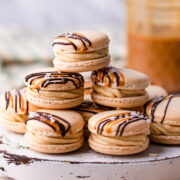
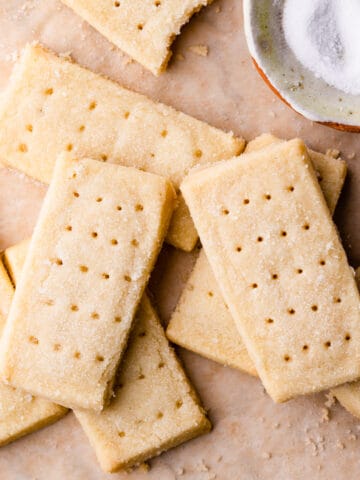



Elizabeth
These look incredible - love a good macaron! Thanks for the recipe!
Liz
Wow! The salted caramel filling is phenomenal!! These could be my new favorite macaron flavor!!!